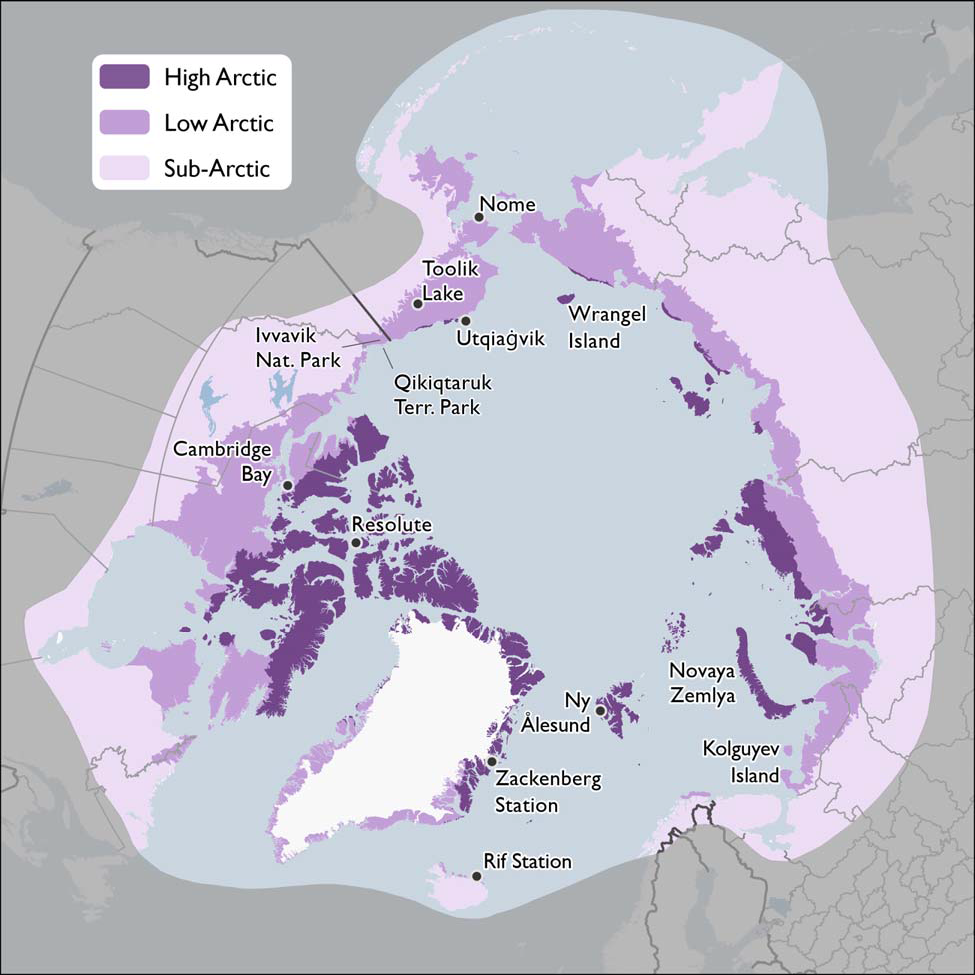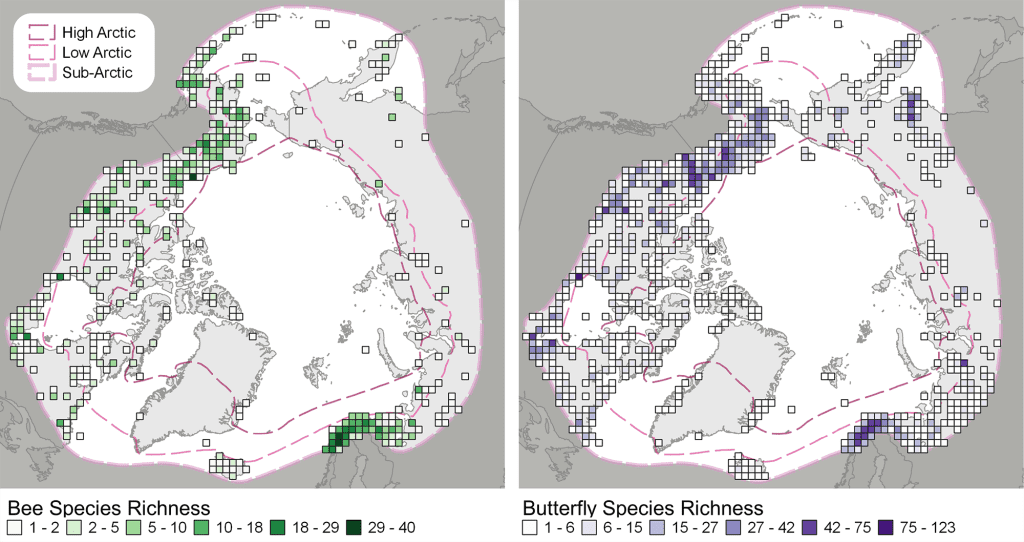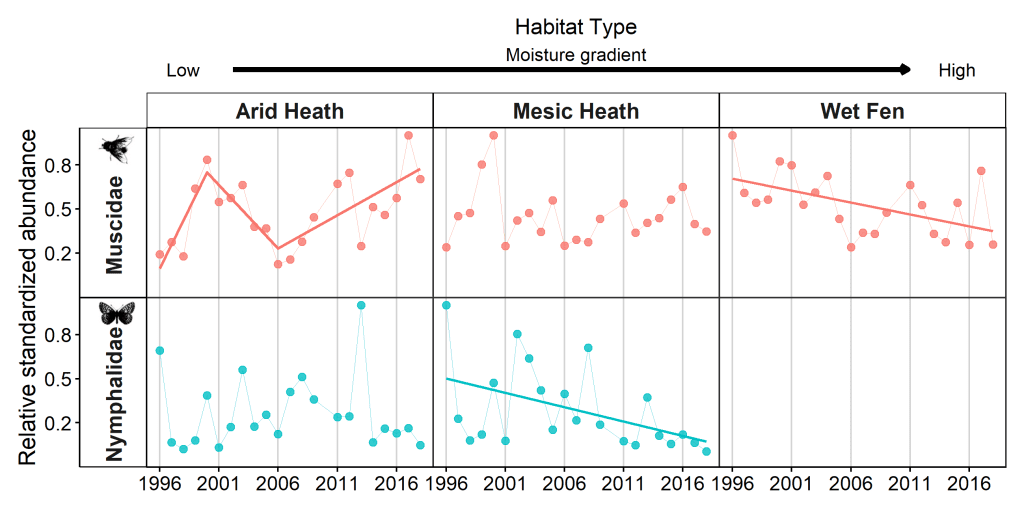C. T. Burns1, M. L. Burns2, S. Cannings3, M. L. Carlson4, S. Coulson5, M. A. K. Gillespie6, T. T. Høye7, D. MacNearney8, E. Oberndorfer9, J. J. Rykken4, and D. S. Sikes10
1Bureau of Land Management, U.S. Department of the Interior, Anchorage, AK, USA
2U.S. Fish & Wildlife Service, Anchorage, AK, USA
3Canadian Wildlife Service, Environment and Climate Change Canada, Whitehorse, YT, Canada
4Alaska Center for Conservation Science, University of Alaska Anchorage, Anchorage, AK, USA
5University Centre in Svalbard, Longyearbyen, Svalbard, Norway
6Department of Environmental Sciences, Western Norway University of Applied Sciences, Sogndal, Vestland, Norway
7Department of Ecoscience and Arctic Research Center, Aarhus University, Aarhus, Denmark
8Wildlife Research Division, Environment and Climate Change Canada, Ottawa, ON, Canada
9Agriculture and Agri-Food Canada, Goose Bay, NL, Canada
10University of Alaska Museum, University of Alaska Fairbanks, Fairbanks, AK, USA
Highlights
- Pollinating insects are critical to the function of Arctic ecosystems and to the food systems of Arctic Indigenous Peoples and Arctic residents. The distribution, conservation status, and ecology of most Arctic pollinators are poorly known due to few long-term research and monitoring sites and geographically limited inventory sampling.
- In the high Arctic, there are 14 known bee species and 17 known butterfly species; in the low Arctic, there are 58 known bee species and 95 known butterfly species. The number of pollinating fly species is unknown.
- Coordinated long-term monitoring, strategic inventories, emerging technologies, engagement with Indigenous Peoples, and resources to support these efforts can improve our understanding of the status of pollinators and their habitats, and inform effective conservation strategies.
Introduction
Knowledge of Arctic pollinators is deficient, despite their important functional roles in terrestrial ecosystems and contribution to the food systems of Arctic Indigenous Peoples and Arctic residents. As is the case in non-Arctic ecosystems, some Arctic flowering plants are highly dependent on particular pollinator taxa for fruit and seed production. However, there are also unique features of Arctic pollination, such as the increasingly important roles at higher latitudes of nectar- and pollen-feeding fly species as pollinators (Hodkinson 2018; Tiusanen et al. 2016; Koch et al. 2020).
Arctic insects are sensitive indicators of ecological responses to climate change (Høye 2020). Some Arctic pollinators are responding strongly to changing conditions, but a full understanding of their responses is lacking. Coordinated monitoring to track changes in the distribution and abundance of Arctic insects is required to understand the capabilities and limits of Arctic pollinators under ongoing climate change (Gillespie et al. 2020a,b). Here, we provide an inventory and monitoring summary across the Arctic and describe recent initiatives to advance further data collection and synthesis.
Inventory, monitoring, and research summary
North America: Pollinator data are particularly limited in the North American Arctic; from a total area of approximately two million km2, there are less than 8,000 curated bee specimens. Specimens are primarily associated with larger communities and research stations (Fig. 1) while other areas are nearly devoid of data (Fig. 2). In Canada, the Northern Insect Survey (1947-62) sampled 39 sites across high and low Arctic zones; in 2010-11, twelve of these sites were resampled by the Northern Biodiversity Program using a standardized protocol. Recent targeted pollinator surveys in some of Alaska’s Arctic National Parks have provided numerous records of solitary bee and syrphid fly species. In 2020, federal, state, university, and community scientists launched the Alaska Bee Atlas to increase species distribution and habitat data, especially in poorly sampled ecoregions. The Arctic BIOSCAN project is developing capacity for community and DNA-based biodiversity monitoring in the Canadian Arctic.


There are 21 bumble bee (Bombus) species associated with the three Arctic zones in the U.S. and Canada, six of which occur in the high Arctic (Table 1). Bumble bees in this region are well-represented by the tundra specialist subgenus Alpinobombus and the more generalist subgenus Pyrobombus. Twenty-four species of solitary (non-social) bees have been collected in the low Arctic in North America, and none have been recorded in the high Arctic (Table 1). These species tend to be abundant generalist pollinators with widespread distributions in the adjacent sub-Arctic. Within the low Arctic, these solitary bee species are largely associated with floodplains and south-facing bluffs, and warm and dry microsites with sandy substrates that provide suitable habitat for these primarily ground-nesting species. The importance of intensive inventory is highlighted in Fig. 2, where a single dark pixel near the Canada-US border represents 732 records of 35 bee species within the diverse ecosystems of Ivvavik National Park and Qikiqtaruk Territorial Park, Yukon, Canada.
| Genus | English Common Name |
High Arctic Zone |
Low Arctic Zone |
Sub- Arctic Zone |
High/Low Arctic Only | US | Ca | Gr | Ic | No | Sw | Fi | Ru |
|---|---|---|---|---|---|---|---|---|---|---|---|---|---|
| Andrena | Mining Bees | – | 5 | 10 | – | 4 | 7 | – | – | 6 | 4 | 3 | 7 |
| Bombus | Bumble Bees | 14 | 38 | 62 | 4 | 21 | 25 | 2 | 7 | 30 | 25 | 23 | 46 |
| Coelioxys | Cuckoo Leaf-cutter Bees | – | 2 | 2 | – | – | 2 | – | – | – | – | – | – |
| Colletes | Plasterer Bees | – | 1 | 2 | – | 1 | 2 | – | – | 1 | – | – | 2 |
| Halictus | Sweat Bees | – | 1 | 2 | – | 1 | 1 | – | – | – | – | – | 1 |
| Lasioglossum | Sweat Bees | – | 3 | 8 | – | 4 | 4 | – | – | 3 | 2 | 2 | 5 |
| Megachile | Leaf-cutter Bees | – | 4 | 5 | – | 2 | 4 | – | – | – | 1 | – | 2 |
| Nomada | Wandering Cuckoo Bees | – | 2 | 4 | 1 | 1 | 2 | – | – | 1 | 2 | 1 | 2 |
| Osmia | Mason Bees | – | 5 | 12 | – | 5 | 2 | – | – | 4 | 5 | 5 | 9 |
| Panurginus | Fairy Bees | – | 1 | 1 | – | 1 | – | – | – | – | – | – | – |
| Stelis | Cuckoo Carder Bees | – | 1 | 1 | 1 | 1 | 1 | – | – | – | – | – | – |
| Other species – | Sub-Arctic Only | – | – | 5 | – | 1 | 2 | – | 1 | 2 | 2 | 2 | 3 |
| Bee Totals | 14 | 63 | 114 | 6 | 42 | 52 | 2 | 8 | 47 | 41 | 36 | 77 |
– = no species records known to authors. US = United States, Ca = Canada, Gr = Greenland, Ic = Iceland, No = Norway, including Svalbard and Jan Mayen, Sw = Sweden, Fi = Finland, Ru = Russia. Complete species table is available at: https://geo.abds.is/
A total of 61 butterfly species are recorded in low Arctic North America; 15 of these are also known from the high Arctic. Colias johanseni, endemic to Nunavut, is the only species known to be restricted to the Arctic. Flies and other insect pollinating groups such as beetles, moths, and wasps are poorly known in Arctic North America.
Nordic Region: Country-level inventories in the Nordic region are robust for most countries (Gillespie et al. 2020b), but data on species distributions outside of mainland Europe, as well as trends in abundance and diversity generally are lacking. Improvements are likely, with monitoring due to start at the Rif Station in Iceland (Gillespie et al. 2020a) and already underway at Ny Ålesund in Svalbard. Additionally, plans for national pollinator monitoring schemes are in advanced stages in Norway, Sweden, and Finland, although not necessarily in representative sub-Arctic sites yet (e.g., Åström et al. 2020).
The most comprehensive knowledge of temporal trends in this region come from the Zackenberg Research Station in East Greenland, which has recorded annual pitfall trap catches of insects since 1996. Family-level analyses of 25 years of data demonstrated variable trends among pollinator groups, dependent on habitat type (Fig. 3; Høye et al. 2021). For example, nymphalid butterflies (two recorded species) have been declining steadily in abundance since 1996, but only in mesic heath habitat. In contrast, muscid flies (37 species) have declined in the wet fen sampling sites, but populations have fluctuated in arid heath. At the species level, trends are also variable, with declines in abundance of seven out of 14 muscid species between 1996 and 2014, and over 80% decreases in diversity and abundance in some habitat types (Gillespie et al. 2020b).

In the high and low Arctic Nordic region, the most important pollinators are likely flies. In Greenland, there are only two bumble bees and eight established butterfly species, but muscid flies, particularly in the genus Spilogona, are more abundant and frequent flower visitors (Gillespie et al. 2020b). In Iceland, syrphid flies are more widespread with most bumble bee and butterfly species restricted to the sub-Arctic south and a general lack of solitary bees. Bees and butterflies are absent from Jan Mayen and Svalbard, where flies often make up the majority of flower visits.
In northern Norway, Sweden, and Finland, the bee and butterfly fauna are more diverse (Tables 1 and 2), closely linked to southern populations and habitats, and likely more important for wildflower pollination. Tundra and alpine specialists are found in the region, together with more widespread temperate species. However, few studies have focused attention on the status and trends of the sub-Arctic ranges of these species.
| Genus | English Common Name |
High Arctic Zone |
Low Arctic Zone |
Sub- Arctic Zone |
High/Low Arctic Only | US | Ca | Gr | Ic | No | Sw | Fi | Ru |
|---|---|---|---|---|---|---|---|---|---|---|---|---|---|
| Aglais | Tortoiseshells | – | 1 | 3 | – | 1 | 1 | 1 | 2 | 2 | 1 | 2 | 2 |
| Agriades | Blues | 1 | 2 | 2 | – | 2 | 2 | 1 | – | – | – | – | – |
| Anthocharis | Orange-tips | – | 1 | 1 | – | – | – | – | – | 1 | 1 | 1 | 1 |
| Aporia | Black-veined Whites | – | 1 | 1 | – | – | – | – | – | 1 | – | 1 | 1 |
| Boloria | Fritillaries | 7 | 16 | 17 | 1 | 9 | 10 | 2 | – | 11 | 11 | 11 | 16 |
| Brenthis | Fritillaries | – | 1 | 1 | – | – | – | – | – | – | 1 | – | 1 |
| Callophrys | Elfins / Hairstreaks | – | 1 | 4 | – | 2 | 2 | – | – | 1 | 1 | 1 | 1 |
| Carterocephalus | Skippers | – | 2 | 2 | – | 1 | 1 | – | – | 1 | – | 1 | 2 |
| Celastrina | Spring Azures | – | 1 | 2 | – | 1 | 1 | – | – | 1 | – | 1 | 1 |
| Coenonympha | Ringlets | – | 1 | 3 | – | 1 | 1 | – | – | 1 | 1 | 2 | 3 |
| Colias | Sulphurs | 3 | 9 | 13 | 1 | 8 | 10 | 1 | 1 | 3 | 3 | 3 | 6 |
| Cupido | Tailed Blues | – | 2 | 2 | – | 1 | 1 | – | – | 1 | 1 | – | 1 |
| Cyaniris | Blues | – | 1 | 1 | – | – | – | – | – | 1 | 1 | – | 1 |
| Erebia | Alpines | 1 | 13 | 25 | – | 11 | 9 | – | – | 7 | 3 | 5 | 20 |
| Erynnis | Duskywings | – | 1 | 3 | – | 1 | 3 | – | – | – | – | – | – |
| Euchloe | Marbles | – | 1 | 5 | – | 2 | 3 | – | – | – | – | – | 4 |
| Euphydryas | Checkerspots | – | 2 | 4 | – | 1 | 1 | – | – | 1 | 1 | 1 | 3 |
| Glaucopsyche | Silvery Blues | – | 1 | 1 | – | 1 | 1 | – | – | – | – | – | 1 |
| Hesperia | Branded Skippers | – | 1 | 1 | – | 1 | 1 | – | – | 1 | 1 | 1 | 1 |
| Icaricia | Mission Blues | – | 1 | 1 | – | 1 | 1 | – | – | – | – | – | – |
| Issoria | Fritillaries | – | 1 | 1 | – | – | – | – | – | – | – | – | 1 |
| Limenitis | Admirals | – | 1 | 2 | – | 1 | 1 | – | – | – | – | – | 1 |
| Lycaena | Coppers | 1 | 2 | 7 | – | 2 | 3 | 1 | – | 3 | 2 | 3 | 5 |
| Nymphalis | Tortoiseshells | – | 2 | 3 | – | 2 | 3 | – | 1 | 1 | 1 | 1 | 3 |
| Oeneis | Arctics | 2 | 8 | 13 | – | 8 | 9 | – | – | 2 | 2 | 2 | 9 |
| Papilio | Swallowtails | – | 2 | 2 | – | 2 | 2 | – | 1 | 1 | 1 | 1 | 1 |
| Parnassius | Parnassians | – | 2 | 6 | 1 | 2 | 2 | – | – | – | – | – | 6 |
| Phyciodes | Crescents | – | 1 | 2 | – | 1 | 2 | – | – | – | – | – | – |
| Pieris | Whites | – | 3 | 6 | – | 1 | 3 | – | 3 | 4 | 1 | 3 | 4 |
| Plebejus | Blues | – | 5 | 6 | – | 1 | 1 | – | – | 5 | 4 | 3 | 6 |
| Polygonia | Commas | – | 2 | 5 | – | 2 | 4 | – | 1 | 1 | – | – | 1 |
| Polyommatus | Blues | – | 2 | 3 | – | – | – | – | – | 1 | 2 | 1 | 3 |
| Pontia | Checkered Whites | – | 2 | 4 | – | 1 | 2 | – | – | 1 | – | 2 | 2 |
| Pyrgus | Grizzled Skippers | – | 2 | 2 | – | 1 | 1 | – | – | 2 | 2 | 2 | 2 |
| Vanessa | Ladies and Admirals | 2 | 1 | 2 | – | – | 2 | 2 | 2 | 2 | 2 | 2 | 2 |
| Other species – | Sub-Arctic Only | – | – | 31 | – | 2 | 9 | – | 2 | 9 | 1 | 6 | 21 |
| Butterfly Totals | 17 | 95 | 186 | 3 | 70 | 92 | 8 | 13 | 65 | 44 | 56 | 132 |
– = no species records known to authors. US = United States, Ca = Canada, Gr = Greenland, Ic = Iceland, No = Norway, including Svalbard and Jan Mayen, Sw = Sweden, Fi = Finland, Ru = Russia. Complete species table is available at: https://geo.abds.is/
Russia: Russia has a long history of engaging in insect conservation, but there is generally a lack of systematic pollinator monitoring (Fig. 2). Nevertheless, contributions to biodiversity databases reveal particularly high species richness (132 butterfly, 46 bumble bee, and 31 other bee species) across the three Arctic zones, including many taxa not represented in the other Arctic countries (Tables 1 and 2). Bumble bees appear to be well-represented in low Arctic regions, in particular species in the subgenus Alpinobombus and other more widespread species, whereas only nine species are found in the high Arctic. Recent research on Bombus glacialis, found only on Wrangel, Novaya Zemlya, and Kolguyev Islands, demonstrates that these isolated populations are under considerable threat from climate change (Potapov et al. 2021).
Across the circum-Arctic, only four bee and one butterfly species are restricted to only the high and low Arctic zones, whereas many species are shared with the sub-Arctic and beyond. The largest proportion of high and low Arctic species are low Arctic species that also are found in the sub-Arctic. These species may, however, be restricted to isolated tundra habitats in the sub-Arctic.
Current coordination efforts and next steps
The February 2022 Conservation of Arctic Flora and Fauna (CAFF) Arctic Pollinator Monitoring Workshop convened experts to communicate existing and upcoming Arctic pollinator research, identify knowledge gaps, and build new partnerships towards coordinating monitoring efforts. This workshop was inspired in part by recent syntheses of status and trends of Arctic insects (Gillespie et al. 2020b) and the CAFF State of the Arctic Terrestrial Biodiversity Report (Aronsson et al. 2021). Research needs identified at the workshop include shared inventory and monitoring protocols, centralized data storage, increased taxonomic and ecological attention to flies, and long-term studies on ecologically important Arctic bee species to better understand the effects of climate change and other stressors on bee abundance, phenology, and distribution.
National and continental-scale monitoring projects are in development in North America and Europe that intersect the Arctic. Cooperation with monitoring in adjacent boreal forests provides a wealth of data, expertise, and collaborative opportunities, as these areas are intrinsically linked ecologically to the more northerly latitudes. Indigenous-led monitoring and observation platforms, including programs through the Gwich’in Tribal Council, Nunavik Sentinels, and the SIKU.org app, provide local training and employment opportunities for Indigenous Peoples while generating critical pollinator data and insights.
DNA barcoding, digital imagery, and machine learning are increasingly valuable tools for monitoring and research, as demonstrated by the multinational BITCue project, furthering understanding of the relative importance of Arctic pollinator species (Mann et al. 2022). There is great potential and need for partnerships with Indigenous governments and communities; for leveraging ongoing monitoring in existing non-pollinator research networks (e.g., Program for Regional and International Shorebird Monitoring/PRISM); and for citizen science platforms (e.g., iNaturalist). Building and maintaining long-term partnerships at multiple scales supports pollinator monitoring that is coordinated, has robust spatial coverage, is cost-effective, and helps identify shared priorities for the future of Arctic pollinator monitoring.
Methods and data
Online data were accessed from publicly available resources. Nordic and Russia data from GBIF.org occurrence data were downloaded August 2022. North American data from Philip and Ferris (2016), Rykken (2017), University of Alaska Museum (2021), GBIF.org were downloaded February 2021, Alaska Center for Conservation Science (2022), https://www.leifrichardson.org/bumble-bees-of-north-america.html were downloaded August 2022, Dumesh and Sheffield (2014), Canadian Endangered Species Conservation Council (2016), and Layberry et al. (1998).
Acknowledgments
We appreciate the valuable feedback from our reviewers, S. H. Woodard, D. Roy, and G. Castellanos, and the Arctic Report Card editors. Thanks to M. Geist for GIS support. We recognize the foundation of this paper was laid by Gillespie et al.’s (2020a,b) Ambio articles, the CAFF START Report, and participants in the 2022 CAFF Arctic Pollinator Monitoring Workshop.
References
Alaska Center for Conservation Science, 2022: Seward Peninsula bees identified from USGS bycatch. Unpublished data, University of Alaska Anchorage.
Aronsson, M., and Coauthors, 2021: State of the Arctic Terrestrial Biodiversity Report. Conservation of Arctic Flora and Fauna International Secretariat, Akureyri, Iceland. ISBN 978-9935-431-94-3.
Åström, S., J. Åström, K. Bøhn, J. O. Gjershaug, A. Staverløkk, S. Dahle, and F. Ødegaard, 2020: Nasjonal overvåking av dagsommerfugler og humler i Norge. Oppsummering av aktiviteten i 2019. (National monitoring of butterflies and bumble bees in Norway. Summary of activities in 2019). NINA Report 1811. Norwegian Institute for Nature Research. Trondheim, May 2020. ISBN: 978-82-426-4569-2.
Canadian Endangered Species Conservation Council, 2016: Wild Species 2015: The General Status of Species in Canada. National General Status Working Group, https://www.wildspecies.ca/reports.
Dumesh, S., and C. S. Sheffield, 2014: Illustrated Keys to the Bees of the Northwest Territories, Canada. Government of the Northwest Territories, Culture & Communications.
Gillespie, M. A. K., and Coauthors, 2020a: Circumpolar terrestrial arthropod monitoring: A review of ongoing activities, opportunities and challenges, with a focus on spiders. Ambio, 49, 704-717, https://doi.org/10.1007/s13280-019-01185-y.
Gillespie M. A. K., and Coauthors, 2020b: Status and trends of terrestrial arthropod abundance and diversity in the North Atlantic region of the Arctic. Ambio, 49, 718-731, https://doi.org/10.1007/s13280-019-01162-5.
Hodkinson, I. D., 2018: Insect Biodiversity: Science and Society, Volume II. Insect Biodiversity, R. G. Foottit and P. H. Adler, Eds., John Wiley & Sons Ltd., 15-57, https://doi.org/10.1002/9781118945582.ch2.
Høye, T. T., 2020: Arthropods and climate change – arctic challenges and opportunities. Curr. Opin. Insect Sci., 41, 40-45, https://doi.org/10.1016/j.cois.2020.06.002.
Høye, T. T., S. Loboda, A. M. Koltz, M. A. K. Gillespie, J. J. Bowden, and N. M. Schmidt, 2021: Nonlinear trends in abundance and diversity and complex responses to climate change in Arctic arthropods. P. Natl. Acad. Sci., 118(2), e2002557117, https://doi.org/10.1073/pnas.2002557117.
Koch, V., L. Zoller, J. M. Bennett, and T. M. Knight, 2020: Pollinator dependence but no pollen limitation for eight plants occurring north of the Arctic Circle. Ecol. Evol., 10(24), 13664-13672, https://doi.org/10.1002/ece3.6884.
Layberry, R. A., P. W. Hall, and J. D. Lafontaine, 1998: The Butterflies of Canada. University of Toronto Press, Toronto.
Mann, H. M. R., A. Iosifidis, J. U. Jepsen, J. M. Welker, M. J. J. E. Loonen, and T. T. Høye, 2022: Automatic flower detection and phenology monitoring using time-lapse cameras and deep learning. Remote Sens. Ecol. Conserv., https://doi.org/10.1002/rse2.275.
Philip, K. W., and C. D. Ferris, 2016: Butterflies of Alaska: A Field Guide. 2nd ed. Alaska Entomological Society.
Potapov, G. S., and Coauthors, 2021: The last refugia for a polar relict pollinator: isolates of Bombus glacialis on Novaya Zemlya and Wrangel Island indicate its broader former range in the Pleistocene. Polar Biol., 44, 1691-1709, https://doi.org/10.1007/s00300-021-02912-6.
Rykken, J., 2017: Insect pollinators of Gates of the Arctic NPP: A preliminary survey of bees (Hymenoptera: Anthophila) and flower flies (Diptera: Syrphidae). Natural Resource Report NPS/GAAR/NRR-2017/1541. National Park Service, Fort Collins, CO.
Tiusanen, M., P. D. N. Hebert, N. M. Schmidt, and T. Roslin, 2016: One fly to rule them all-muscid flies are the key pollinators in the Arctic. P. Roy. Soc. B.-Biol. Sci., 283, 20161271, https://doi.org/10.1098/rspb.2016.1271.
University of Alaska Museum, 2021: Arctos database. https://arctos.database.museum/collection/UAMObs:Ento, accessed February 2021.
December 2, 2022

